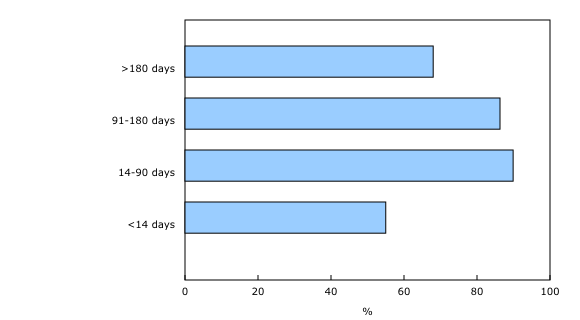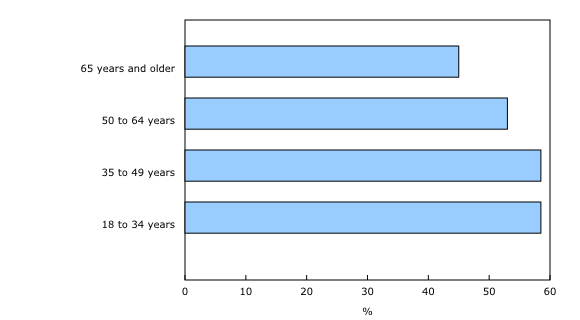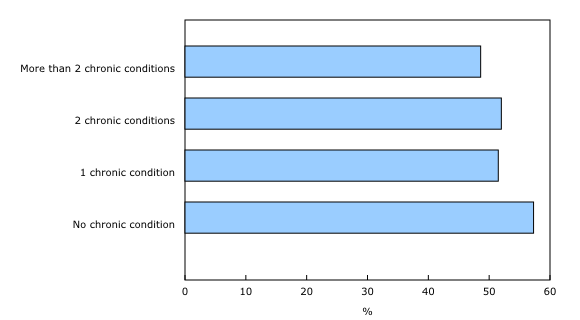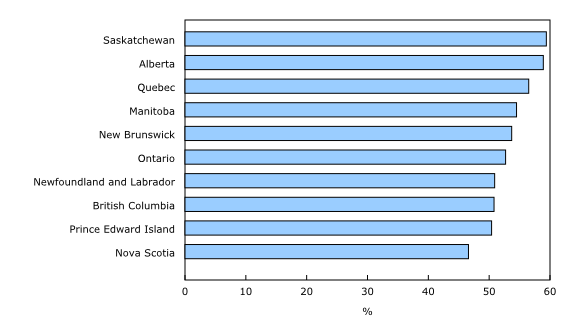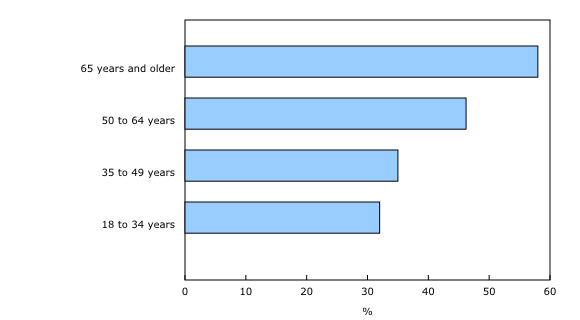Between April and August 2022, 98% of Canadians had antibodies against COVID-19 and 54% had antibodies from a previous infection
Archived Content
Information identified as archived is provided for reference, research or recordkeeping purposes. It is not subject to the Government of Canada Web Standards and has not been altered or updated since it was archived. Please "contact us" to request a format other than those available.
Released: 2023-03-27
Statistics Canada, in partnership with the Public Health Agency of Canada and Canada's COVID-19 Immunity Task Force, conducted the second cycle of the Canadian COVID-19 Antibody and Health Survey (CCAHS-2) to better understand the spread of SARS-CoV-2, the virus that causes COVID-19, and the longer-term impacts of COVID-19 in Canadian adults. This unique survey combines self-reported information about past and current infections with direct measures of health, including dried blood spot (DBS) testing to detect antibodies against SARS-CoV-2.
Antibodies are generated as part of the body's defence against infectious diseases, including SARS-CoV-2, and in response to vaccination. Antibodies can decrease over time and some individuals who previously had a SARS-CoV-2 infection or vaccination may no longer have detectable levels of antibodies against the virus—sometimes referred to as "waning" antibody levels. The proportion of Canadians who have these antibodies from an infection or vaccination, identified through blood testing, is referred to as the seroprevalence of SARS-CoV-2 antibodies. Since antibodies resulting specifically from an infection can be detected, the results of the CCAHS-2 will help to better understand the prevalence and characteristics of Canadian adults with infection-acquired antibodies, including the extent to which they were aware or suspected that they had the virus.
Based on DBS samples collected between April and August 2022, nearly all Canadian adults (98.0%) had antibodies against SARS-CoV-2 during that time. These antibodies were acquired through either vaccination, a previous infection, or both. Over this period, 54.1% or about 16.5 million Canadian adults living in private dwellings had antibodies indicating a past infection, which is more than 20 times higher than the 2.6% observed from November 2020 to April 2021.
In the summer of 2022, 2 out of 5 Canadians were unaware that they had been infected with COVID-19
Some people who had antibodies from a past infection were not aware they ever had a SARS-CoV-2 infection. Among Canadians adults in the summer of 2022 with antibodies resulting from a past infection, 48.1% had previously tested positive for the virus at least once. An additional 10.7% with antibodies from infection suspected they had contracted the virus but never tested positive. On the other hand, 41.2% of Canadians with antibodies from a past infection never previously tested positive nor suspected an infection.
In early 2022, self-administered rapid antigen tests (RATs) became the principal way Canadians tested positive for the virus. Most people with antibodies from a past infection who had previously tested positive obtained their result from a RAT (59.4%), compared with 40.6% who received a positive test result from a polymerase chain reaction (PCR) test.
Almost 9 out of 10 Canadian adults who previously tested positive for the virus by PCR or rapid antigen test have antibodies from an infection
Between April and August 2022, 54.1% of Canadians had antibodies from a past infection; still, the actual proportion of those who had been infected since the beginning of the pandemic would likely be higher. This is due, in part, to the fact that an antibody response to an infection may not always be detectable, especially among those who are vaccinated who may generate fewer antibodies following a subsequent infection. In addition, antibody levels can decrease over time.
Among Canadians who reported that they had previously tested positive for the virus, 88.1% had antibodies from a past infection. On the other hand, among those who never tested positive but suspected an infection, 57.8% showed antibodies from a past infection, while 36.8% of Canadians who never tested positive nor suspected an infection showed the presence of infection-acquired antibodies.
The survey included questions about when Canadians first tested positive for the virus. This information was combined with antibody results to better understand how antibody levels may change over time. Antibodies against SARS-CoV-2 are usually detectable within two weeks of infection. Chart 1 demonstrates that among those who reported previously testing positive, levels of antibodies against a SARS-CoV-2 infection were higher from 14 to 90 days after an infection (89.9%) and this percentage gradually decreased over time. While this is indicative of decreasing antibodies, there are other factors which could impact this analysis. For example, since vaccines may lead to a lesser antibody response following an infection, the percentage of Canadians with antibodies from infection may be affected by changing vaccination rates over time. Further, since the survey focuses on first infections, reinfections would also impact this analysis as these could lead to a rebound in antibody levels.
Younger Canadians were among those more likely to have antibodies from a past infection
Many factors may have contributed to a person's exposure to the virus. Throughout the pandemic, public health authorities have provided guidance to reduce the spread of the virus, including limiting close contacts where possible. However, due to factors such as living with others or needing to physically go into work or school, some people were limited in their capacity to avoid exposure to the virus. As a result, some populations may have had more exposure to the virus than others. On the other hand, it was generally understood that some populations were at a higher risk of severe outcomes from the virus, including older Canadians and those with underlying health conditions, and they may have been more likely to take precautions. In fact, the results released today indicate that by the summer of 2022, older Canadians living in private dwellings had fewer antibodies from infection (Chart 2) compared with younger age groups.
Possibly because these individuals were more likely to follow public health recommendations (such as wearing a mask and physical distancing), Canadians living with a chronic symptom, chronic condition, or current cancer were less likely (52.1%) than Canadians without these conditions (58.1%) to have antibodies from a past infection. Seroprevalence also decreased as the numbers of chronic conditions increased (Chart 3). Similarly, Canadians reporting a disability were less likely (48.1%) to have antibodies from infection than those who did not report a disability (54.6%).
Racialized, non-Indigenous Canadians (60.7%) were more likely to have antibodies from infection compared with non-racialized, non-Indigenous Canadians (52.0%). Results also varied by population group. For example, Canadians identifying as Chinese had lower rates of antibodies from infection (53.5%), compared with those who identified as Black (80.7%), Arab (76.3%), Filipino (71.3%) and Latin American (64.6%).
Seroprevalence from infection also varied by province. Nova Scotia (46.6%), Newfoundland and Labrador (50.9%), and Prince Edward Island (50.4%) had a lower seroprevalence compared with Quebec (56.5%), Alberta (58.9%) and Saskatchewan (59.4%) (Chart 4).
Seroprevalence for a past infection was similar for women (54.0%) and men (54.1%).
Over half of Canadians 65 and older with antibodies resulting from an infection were unaware that they ever had the SARS-CoV-2 virus
Some Canadians may have been more likely to know or suspect they had the virus compared with others. This could be due to differences in access to testing, differences in the severity of symptoms, or general awareness of the virus. For example, older Canadians living in private dwellings were less likely to be aware of their infection when compared with younger Canadians (Chart 5).
Looking ahead
Complete results from the second cycle of the CCAHS-2 data are now available. In-depth studies covering a range of topics, such as the impact of the COVID-19 pandemic on healthcare access, are expected in the coming months.
Note to readers
The Canadian COVID-19 Antibody and Health Survey Cycle 2 (CCAHS-2) was administered by Statistics Canada in collaboration with the Public Health Agency of Canada and the COVID-19 Immunity Task Force.
Populations excluded from the CCAHS-2 were persons living in the three territories, persons under 18 years of age, persons living on reserves and other Indigenous settlements in the provinces, persons living in institutions, persons living on Canadian armed forces bases and residents of certain remote regions.
Survey weights were used to create a representative sample and to minimize any potential bias that could arise from survey non-response. Non-response adjustments and calibration using available auxiliary information were also applied and are reflected in the survey weights.
The reference period for this survey, as well as the questionnaire data used in this report, are from April 1 to August 31, 2022. Dried blood spot (DBS) sample collection to identify current SARS-CoV-2 antibodies also began on April 1 and extended to October 17, 2022, to maximize sample collection and allow for samples to arrive in the mail. Most samples were received before August 31, 2022. A small number of DBS samples received after August 31 were excluded from this analysis. Collection was completed over three overlapping periods of approximately equal sample size. The collection period of each of the waves began on April 1, May 10, and June 1. Estimates of seroprevalence are based on participants who completed the DBS sample collection between April and August 2022. They reflect a weighted average over that period of time and should not be considered indicative of a level at a specific point in time.
Respondents were asked to complete the DBS sample collection regardless of whether they had symptoms or not, immediately after completing the electronic questionnaire. Consent to proceed with DBS testing was collected as part of the questionnaire.
The seroprevalence (DBS) data represent the percentage of Canadians who had antibodies against SARS-CoV-2 due to infection, vaccination or both. Laboratory data were combined with questionnaire responses (vaccination status) to determine whether a sample contained antibodies against SARS-CoV-2 due to a previous infection or vaccination. The presence and quantity of three different types of antibodies were measured in the DBS sample: nucleocapsid, spike and receptor binding domain of spike (RBD). Vaccines approved for use in North America can generate antibodies against both spike and RBD, but not nucleocapsid.
An individual was considered to have antibodies from vaccination, past infection or both if they had at least two of the three types of antibodies. If the individual was unvaccinated, antibodies were considered to have been the result of a past infection. However, if the individual was vaccinated, they were considered to have antibodies resulting from a past infection only if they had nucleocapsid antibodies—as well as at least one other type of antibody. Further details on the CCAHS-2, including response rates and analytical methods, can be found in the survey's detailed information page.
A probability-based model was developed in partnership with the University of Ottawa and Sinai Health, to estimate nucleocapsid positivity. The model was derived from a case study of positive and negative samples, confirmed by repeated PCR and rapid antigen tests (RAT), conducted by researchers at Sinai Health. The cohort in this study was followed after the roll-out of vaccines and through the initial onset of the Omicron variant. This study showed that those who were vaccinated tended to generate fewer antibodies following a subsequent infection compared with those who were not vaccinated. The model assumes that the relationship between the past infected status and the nucleocapsid levels in this cohort is representative of the general population covered by the CCAHS-2 between April and August2022.
The probability model was applied to the nucleocapsid data to obtain a probability of testing positive for nucleocapsid. Spike and RBD were considered positive if their values were above a pre-determined threshold. Total seroprevalence (infection and vaccination) was calculated based on the number of samples that had two or more positive antibodies. The sensitivity and specificity of the assays for spike and RBD were not accounted for in the seroprevalence estimations. Further information is available in the study's user guide.
It is important to note that even if someone does not test positive for antibodies, they may still have some level of immunity to COVID-19. In response to vaccination or infection, the immune system responds with cell-mediated and antibody-mediated responses. The CCAHS-2 tests for antibody-mediated immunity. While antibodies may decrease with time, this does not necessarily imply that someone's immunity has waned. Cell-mediated immunity is long lasting and allows the immune system to rapidly respond to new infections. This type of immunity is not measured with DBS testing. Cell-mediated immunity even in the absence of detectable antibodies may be sufficient to protect individuals against severe outcomes of COVID-19. Similarly, the presence of antibodies does not alone suggest that the individual has sufficient protection to ward off a new infection or serious outcomes from the disease.
The seroprevalence of Canadian adults with antibodies from infection by days between self-reported infection and date of sample collection (Chart 1) was calculated based on DBS collection date and reported date of infection and thus is subject to reporting error. If a collection date was not provided by a respondent, the shipping date on the test kit returning envelope was used.
The CCAHS-2 included questions on Canadians' experiences with their first infection, including whether they tested positive on a PCR test or a RAT, as well as those who never tested positive but suspected they had an infection. The data do not account for multiple infections, and it is possible that detected antibodies could have been a result of a reinfection.
Chronic conditions were defined on the questionnaire as conditions expected to last or already lasting six months or more and were diagnosed by a health professional. Chronic symptoms were defined in the questionnaire as "physical or mental symptoms expected to last or already lasting six months or more." They may have been related to an existing health condition or be of unknown cause. Canadians living with a chronic symptom, chronic condition or current cancer were defined as Canadians with one or more chronic symptoms, chronic conditions or cancers.
The following links provide further information on SARS-CoV-2 infection and immunity:
Correction note
A minor adjustment to the calibration step of the survey weights was made on August 3, 2023. This adjustment was made following the addition of area-based variables to the data file, to ensure that the estimates were more precise by level of geography. It had a negligible impact on the survey estimates published in this article, which have now been updated.
Contact information
For more information, or to enquire about the concepts, methods or data quality of this release, contact us (toll-free 1-800-263-1136; 514-283-8300; infostats@statcan.gc.ca) or Media Relations (statcan.mediahotline-ligneinfomedias.statcan@statcan.gc.ca).
- Date modified:


